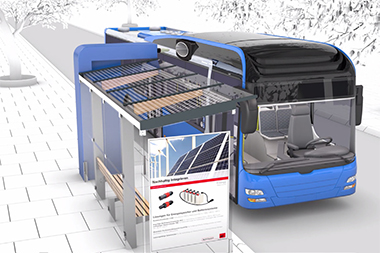Multi-Contact introduces new charging concept for electric buses

Photo by Multi-Contact AG
The driver of the e-bus stops at the marking. A flexible plug immediately extends from the charging station, clicks into the charging socket installed on the bus, and starts charging after a signal is issued. The amount of energy that can be transferred during the short stop is sufficient to recharge the battery. Using this new connector for quick-charge systems, the Swiss connector specialist Multi-Contact paves the way for electric buses to further develop into environmentally friendly inner-city transportation. Charging occurs automatically at regular intervals along the route, without affecting vehicle operation; alternatively, this can be carried out during longer stops at the bus terminus. Due to the repeated charging cycles, the battery size can be kept small; this has a positive effect on the weight of the vehicle and on the operating costs. Winnijar Kauz, the responsible Product Manager at Multi-Contact, explains: “The possibility of ‘filling up’ with charging currents up to 900 A within a short time at bus stops makes electric buses a serious alternative to track-guided trolleybuses and vehicles with internal combustion engines for the first time.”
The system compensates for unbalanced load of the vehicle, deformations of the roadway and inaccurate positioning of the bus using its patented mechanical guide. The funnel-shaped design of the charging socket tolerates positioning inaccuracies of up to 500 mm. Depending on customer requirements, the coaxial plug can be equipped with up to 9 pins (2–3 power contacts, 1 ground contact, 5 signal contacts). Conductor cross sections of up to 95 mm2 permit a large amount of power to be transferred over a short time. An automatic self-cleaning system removes foreign bodies such as dust and leaves before every charging procedure, thus ensuring reliable contact between the bus’s electrical system and the charger. The system is designed for more than 100,000 mating cycles; which also allows generous maintenance intervals.
The entire system is designed to ensure reliability as well as the safety of the driver, passengers, and pedestrians. In all situations – whether the system is plugged in or not – all live parts are out of reach of the passengers and are protected against accidental contact. The power and signal contacts are released only after the contact carrier has been precisely mechanically connected; the electronic release to start charging is then issued. Existing bus lines can easily be retrofitted. Winnijar Kauz states: “The charging station takes up little space and blends unobtrusively into the urban landscape. This system is the clear winner compared to, for example, investing in a trolleybus line.”
For more information, please visit http://www.multi-contact.com.
News Categories
- » NEWS HOME
- » Automation & Robotics
- » Industry 4.0
- » Material Handling
- » Sensors
- » Quality & Testing
- » Machine Vision
- » Laser & Optics
- » Metalworking
- » Motion Control & Drives
- » Hydraulics & Pneumatics
- » Process Industry
- » Renewable Energy
- » Agriculture
- » Home & Office Furniture
- » Environmental Tech




